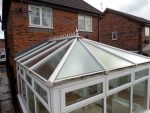If your conservatory is starting to leak or you’re experiencing problems with the temperature, it may be time to consider a new roof. Changing the roof of your conservatory can make it much more energy-efficient.
Polycarbonate sheets are the most popular choice due to being inexpensive and easy to install. However, they are not as insulating as other options and can be easily damaged by weather conditions.
Tiled Roofs
A new tiled roof will transform your conservatory into a room that you can use all year round. It is a popular option when replacing polycarbonate or glass roofs because it helps to create a more comfortable space that can be used for any purpose.
A solid roof is an excellent insulator and can help to reduce energy bills. This is because it can slow down the transfer of heat from outside to inside. It can also be combined with a variety of roof windows to provide light into your conservatory.
Another benefit of a replacement conservatory roof is its acoustic performance. Many people struggle with noise from the rain and wind which can make a conservatory unusable. A solid roof will absorb the sound much like a regular roof does, so your conservatory will be calm and enjoyable even when it is raining.
Glass Roofs
Unlike polycarbonate roofs that often suffer from leaks, temperature regulation and sound absorption issues glass conservatory roofs are much more durable and offer an exceptional level of insulation. They also come with the ability to add a skylight to ensure your conservatory feels light and airy throughout.
Another benefit of a glass conservatory roof is that it can allow more natural light to flow into the extension making it feel like a true garden room. These roofs can also be tinted to always reduce glare while self-cleaning glass is available that uses a special coating that reacts with sunlight to breakdown dirt.
One of the main reasons people choose to upgrade from their old polycarbonate roof is due to the improved thermal qualities a glass conservatory roof offers. This will help to keep your home warmer in winter and cooler in summer. In addition to this, it can help to keep energy bills down. It can even reduce the pitter-patter of rain and outside noises making your conservatory a peaceful retreat to relax in.
UPVC Roofs
UPVC is commonly used in window frames and modern doors, but can also be fitted in a conservatory to offer great roof solutions. It is a strong material, withstands harsh weather conditions and can provide sound insulation. UPVC also helps keep the heat in the conservatory.
However, if you’re looking to upgrade your existing conservatory or build an orangery, it may be better to choose a different roof style and material. This is because polycarbonate roofs don’t provide optimum thermal performance and will restrict the amount of natural light that can enter your room.
Moreover, clad-over solutions require a lot of timber and insulation materials that are often heavy for the original frames. This can cause structural issues and affect the lifespan of your conservatory. You may need to reinforce the original framework. Also, any drilling of the existing frame to create fixing points will affect the structural integrity. This can lead to leaks and cracks.
Low-Pitch Roofs
For a low-pitch roof, there are several roofing materials you can choose from. These include PVC (polyvinyl chloride) roofing membrane, which is a white surface that helps to reflect heat and keep the room below cooler during summer, as well as fibreglass, which is tough, long-lasting and fully waterproof.
UPVC roof tiles are another option, and these offer protection against moisture, photo-oxidation, mold, thermal shifts, severe wind, as well as impacts from foot traffic, hail, snow, and flying debris. Many of these roofing tiles are available with a lifetime guarantee from manufacturers.
A low-pitched roof can benefit from a sloping design that allows rainwater to drain away more effectively than it would on a flat roof. However, you’ll need to pay close attention to the rafter lengths used for this roof type to ensure that water isn’t allowed to pool and cause damage over time. Increasing valley widths and additional guttering can help to avoid this.
